This year marks 110 years since Denon started, something the company celebrates with special models of four popular high-end products with new technology and the best components they have acquired.
Among the selected products is the surround amplifier AVC-A110. A real flagship, based on the home theater monster AVC-X8500H, with as many as 13 amplifier channels. It works just fine, and it does. But object-based audio formats such as Dolby Atmos and DTS: X Pro (Pro has even more channels than usual), which also provide sound in height, sound at their very best with as many channels as possible. This means that the 3D sound image can be drawn with more points, and thus become more precise. Which is important for the most realistic experience of film and games. And music, because there are music releases in these formats. At their best, they sound fantastic, where the acoustics from the recording room envelop us and almost teleport us into the music landscape.
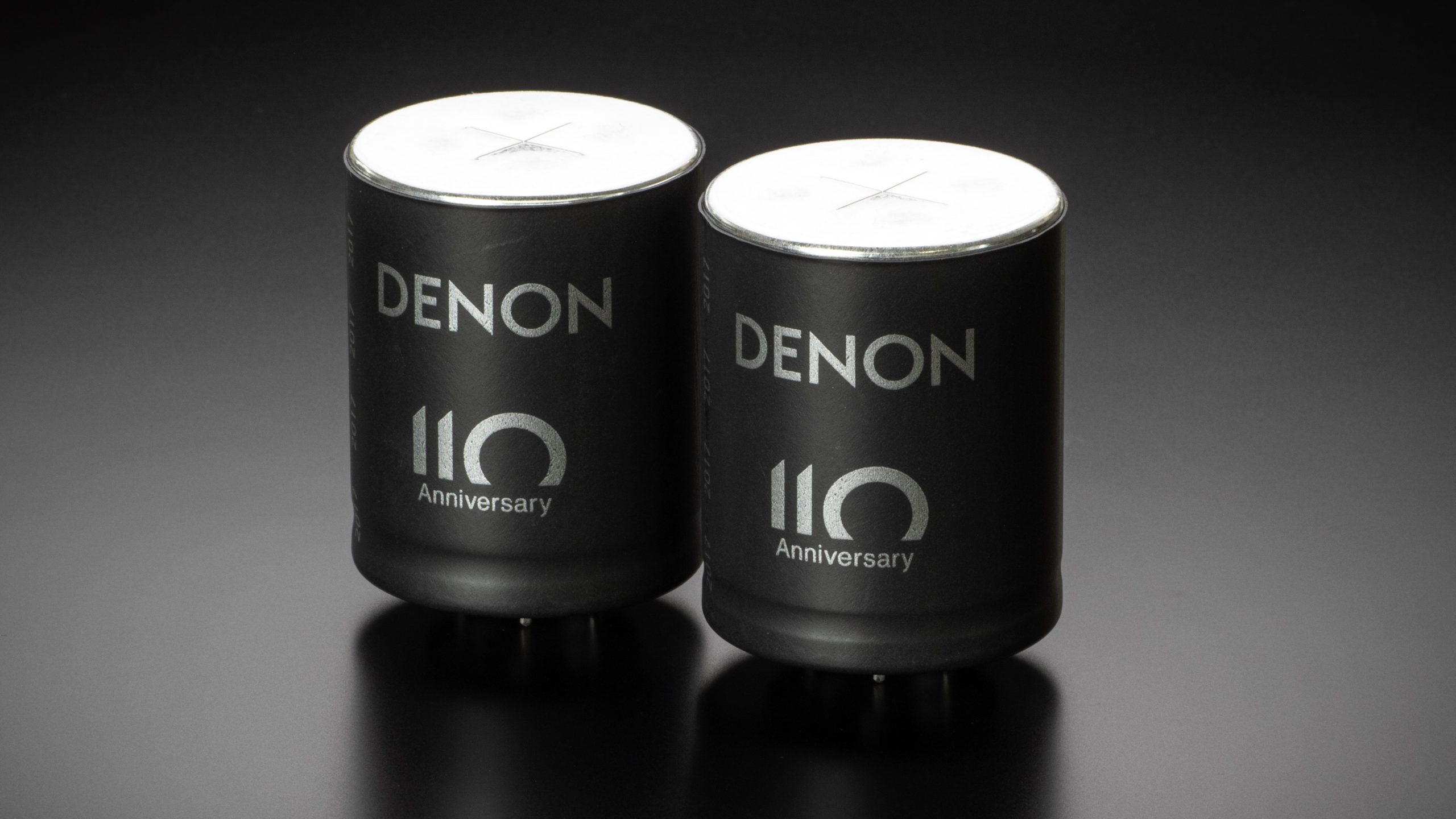
7.1.6
13 channels means that the AVC-A110 can operate a 7.1 surround setup in addition to six additional ceiling speakers (7.1.6). Or have four ceiling speakers and an extra pair of wide front speakers (Front Wide). But while this works well for DTS: X, Front Wide speakers are not supported by Dolby Atmos. Thus, you need to use a DSP mode in the amplifier to bring them to life. After trying a few different options, I personally think it will be toughest with 7.1.6, if I absolutely want to use all the speaker channels.
If you do not want to physically mount speakers in the ceiling, you can choose the second best; namely special Atmos speakers that are placed on top of the main speakers. These then direct the sound up to the ceiling, whereupon it is reflected down on the listening position again, so that you feel the sound coming from above. It works, but does not work as well as with real ceiling speakers.
Auro-3D
An alternative speaker setup for Dolby Atmos and DTS: X is Auro-3D, which the amplifier also supports. Typical here is to connect 10.1 or 11.1, where each speaker placed at ear level has a corresponding speaker in the ceiling above it. In addition to possibly an extra rear center speaker in the ceiling. The format sounds fantastic with recordings recorded in Auro-3D, but the selection is so modest that this becomes too particularly interesting. I would therefore generally recommend using a Dolby Atmos setup.
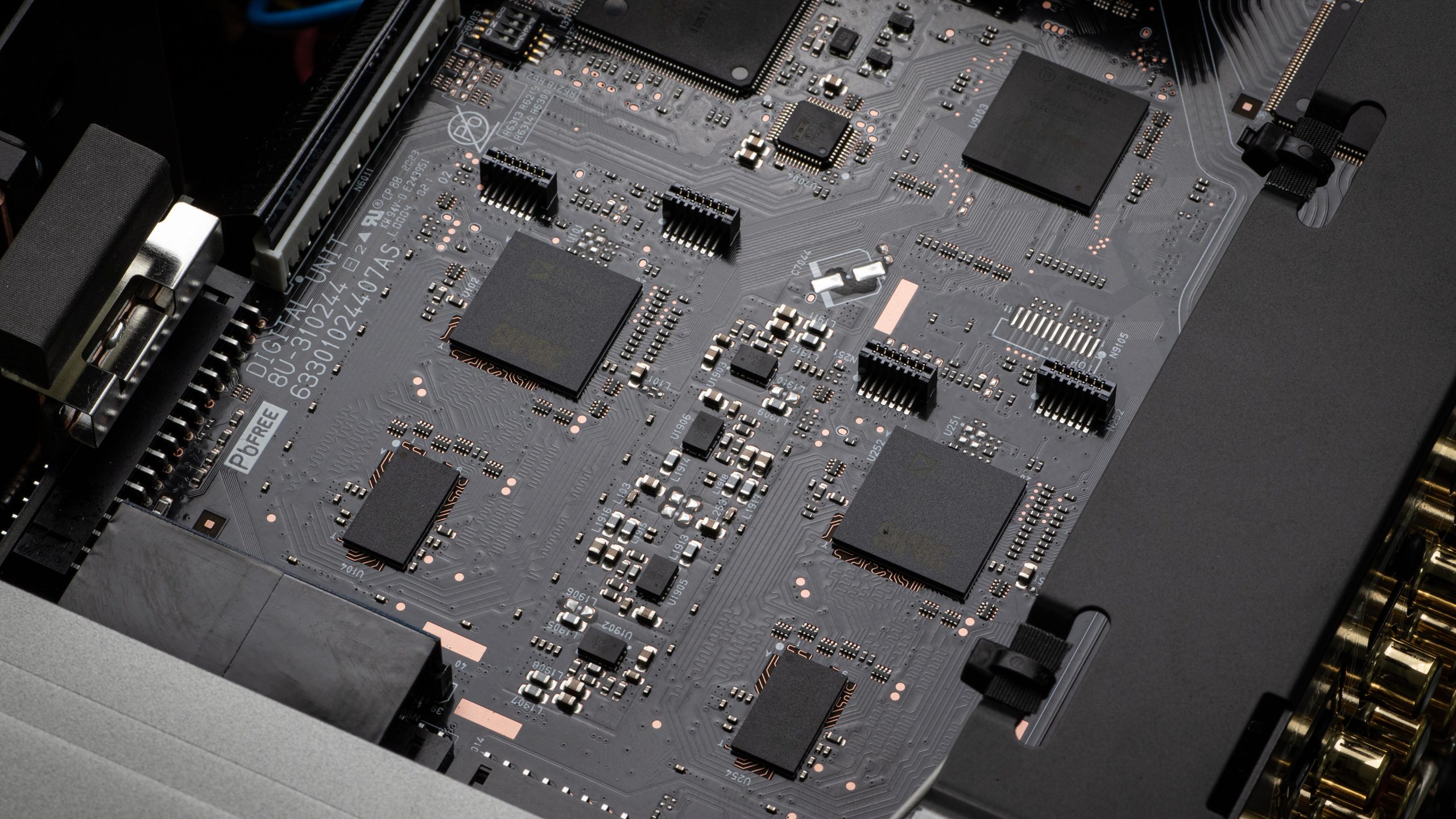
Simulated sound from above
If you do not have the opportunity or desire to place speakers in the ceiling or on top of the main speakers, then the Denon AVC-A110 can offer so-called Dolby Atmos Height Virtualization and DTS Virtual: X, which using advanced digital processing simulates height channels based on a traditional speaker setup. Completely without height speakers. This definitely has its sonic limitations, but if you absolutely can not cope with it, it can give an extra great illusion of 3D sound compared to having this turned off.
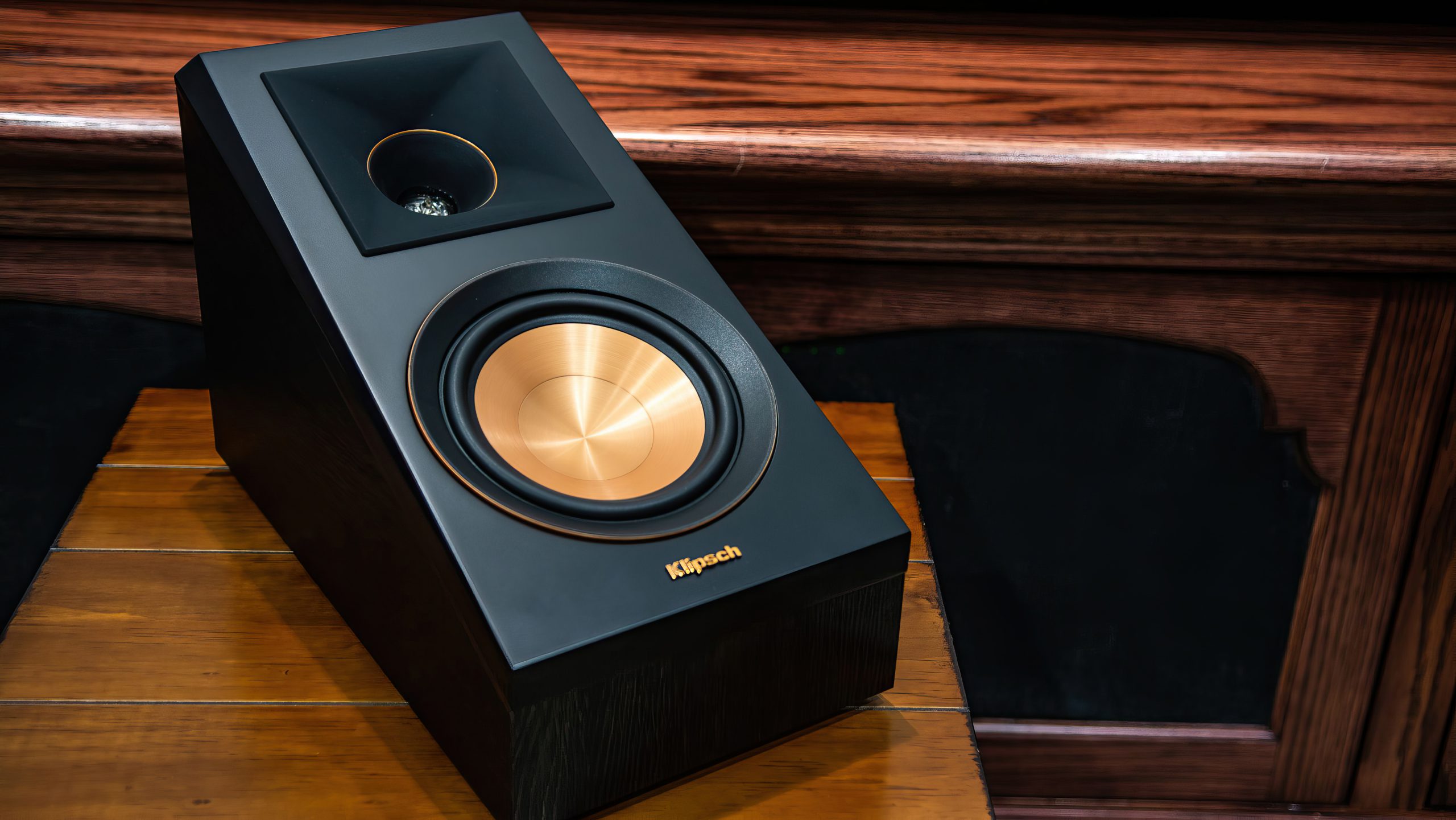
IMAX Enhanced
The AVC-A110 is marked IMAX Enhanced. This means that it supports IMAX, and we promise that a whole range of Sony movie titles will be rolled out during the autumn and winter.
What IMAX Enhanced actually is for something is still a bit out of the blue. On the image side, it appears to be a separate dynamic HDR format packed in parallel with the general static HDR10. If your TV supports IMAX Enhanced, you get the “total IMAX feel”, with dynamic HDR that gives even more life and depth to your pictures. However, if it is not IMAX Enhanced certified, the video titles are displayed with standard HDR10.
On the audio side, on the other hand, it uses IMAX Enhanced titles simply DTS: X audio tracks. The Denon amplifier already supports this, regardless of any IMAX logo. I would think most IMAX titles you are going to watch will come from a streaming service, and then it is the HDMI eARC output from the TV that will be used. In this case, the video format support in the amplifier is irrelevant.
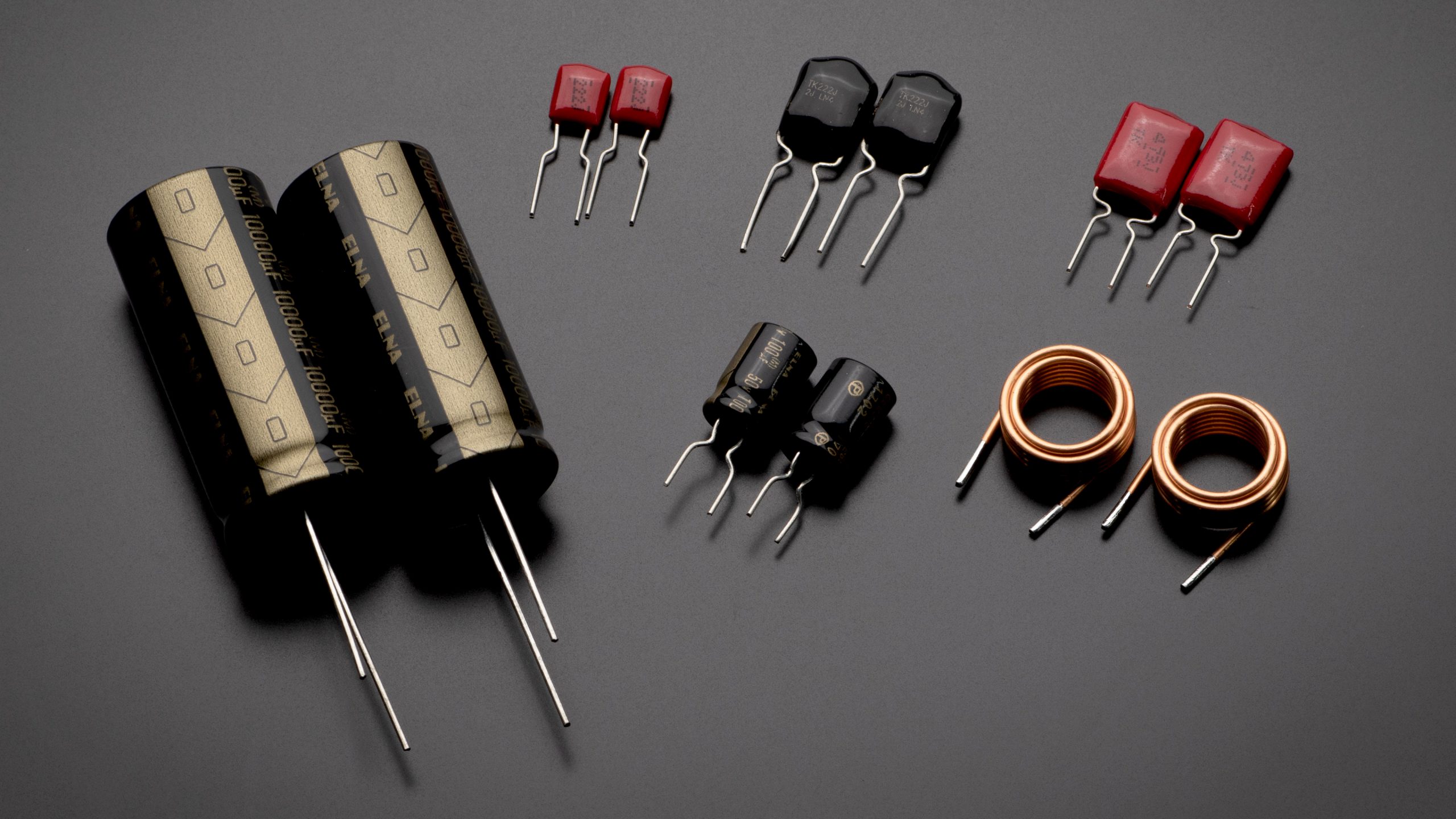
8K video and HDMI 2.1
The Denon amplifier has the latest HDMI circuits (2.1), and supports 8K video signals, and also 4K with a full 120 Hz frame rate. And also variable frame rate, which is useful for gamers. At the moment, unfortunately, all newer receivers and amplifiers from Denon (and Marantz and Yamaha) are struggling with 4K at 120 Hz from the latest game consoles, and give a black image at the other end. The solution, until a firmware update arrives, is to connect the game console to the TV and extract the sound via the audio return channel (HMDI eARC).
HDMI-delay
In any case, there may be good reason to connect the game console or PC to the TV that way, because if the signal passes through the amplifier, you will get an extra video delay. I measured it to somewhere between 13 and 16 milliseconds (ms), depending on which HDMI input I used.
Interestingly, there was a greater delay at the Game input than the Blu-ray input of the AVC-A110. This delay comes on top of the TV’s delay, which will typically be somewhere between 10 and 30 ms if the TV is of newer vintage. In games, you want as low a delay as possible, so I would anyway connect the game directly to the TV, and get the sound from eARC.
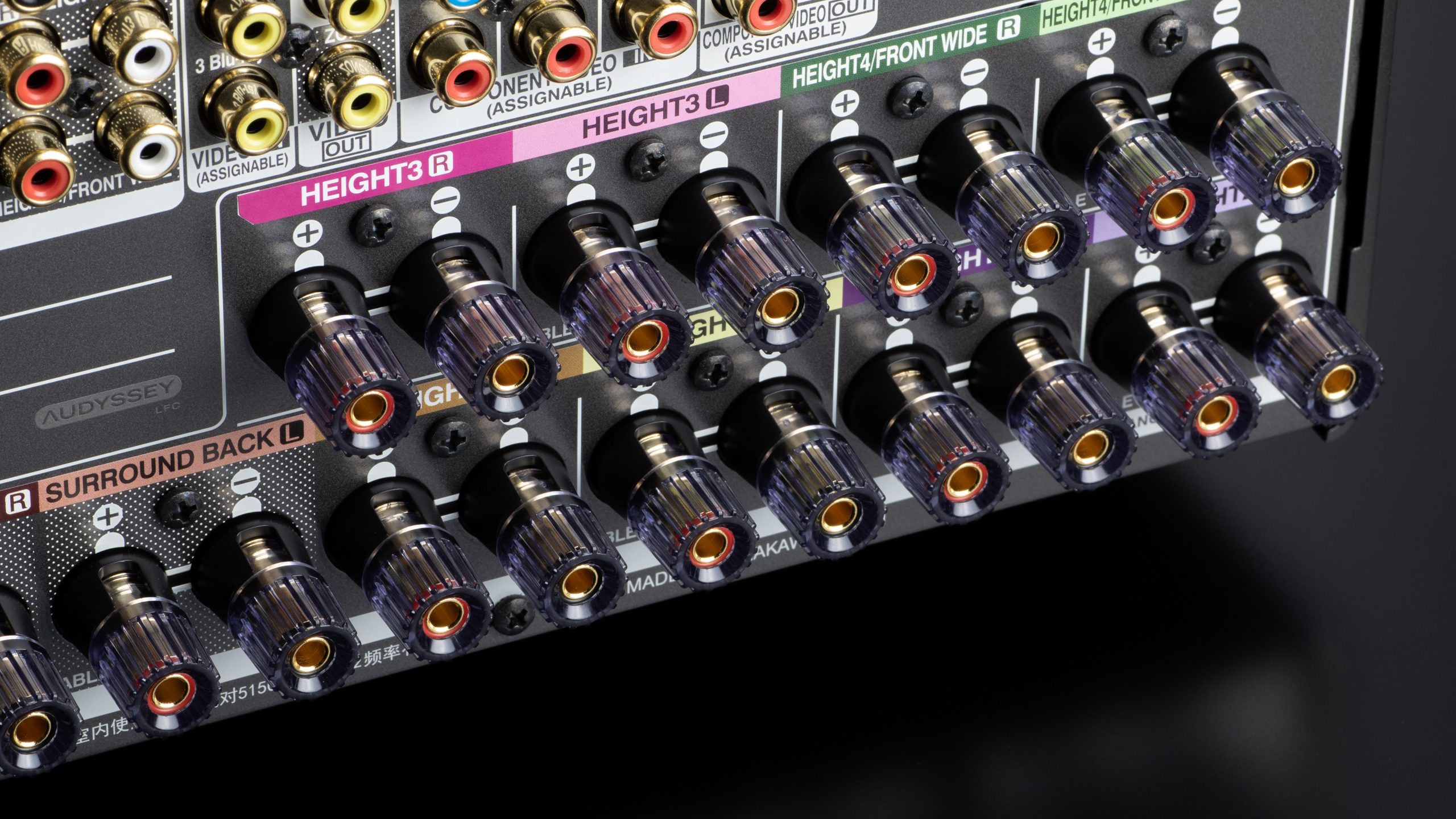
A few boring things
There are a few things I notice. This is an amplifier for 60,000 kroner, but still it has speaker terminals in small plastic. Where will the gold-plated metal terminals go?
A major weakness, which is not only aesthetic, is that the amplifier lacks balanced output to the subwoofer. Here you often need long cable runs, and many may find themselves pulling the subwoofer cable along the wall parallel to live cables. If too much noise is picked up on the road, some subwoofers will hum. Sometimes you can also make ground noise from connected HDMI connectors. A balanced subwoofer output solves this problem.
We have this problem with our Procella subwoofer, my solution was to connect a balanced preamplifier, and pull a long XLR cable from this to the subwoofer. You can also use the DI box.
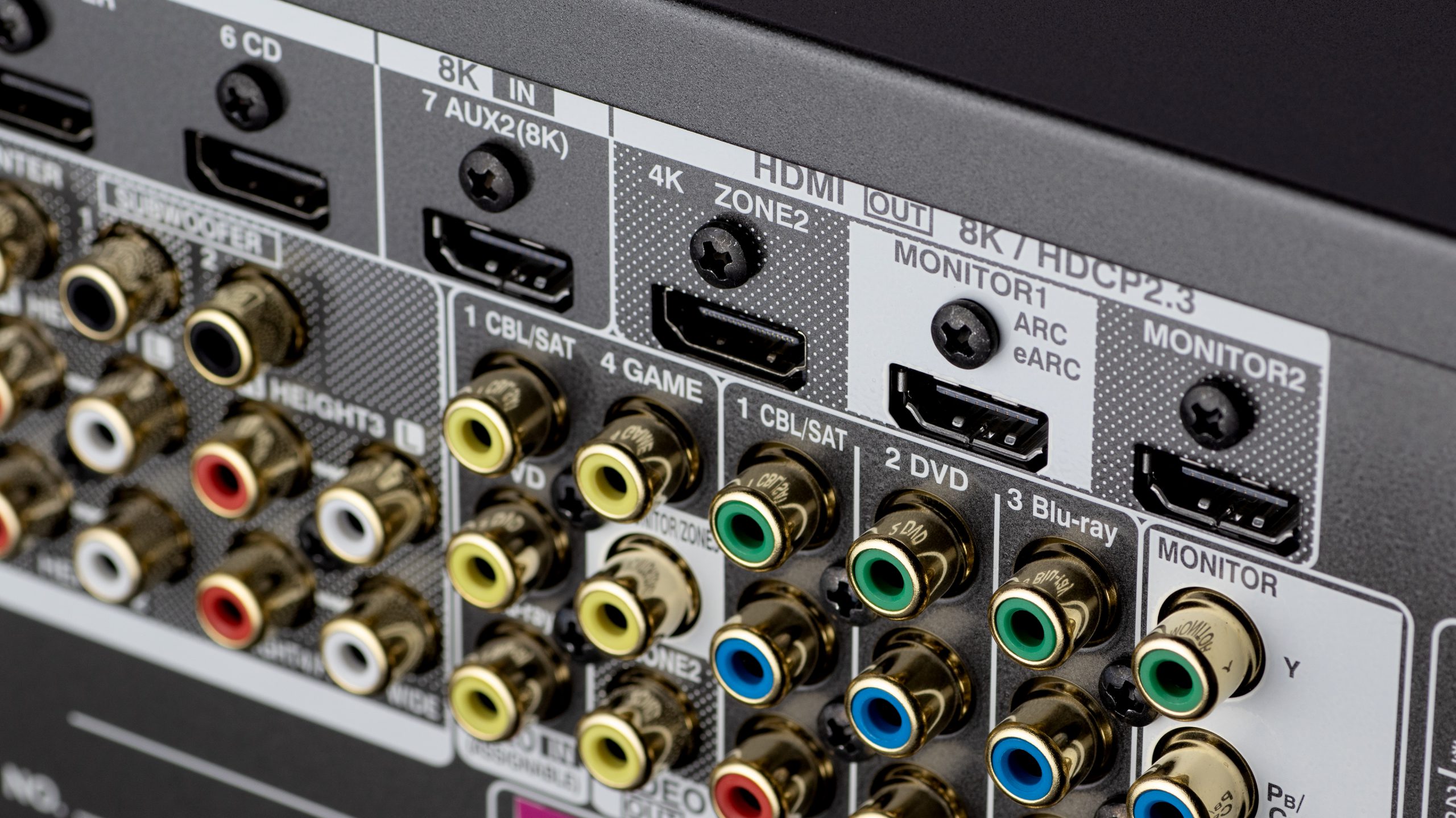
The AVC-A110 is advanced but user-friendly
The AVC-A110 is a very advanced machine, but it is still relatively easy to use. And that despite the fact that the back panel has a fantasillion contacts. But just turn on the amplifier the first time, and it will tell you step by step exactly which plug is going where, and it will then play some music channel by channel, so you can hear if you have connected properly, as the music moves from speaker to speaker.
The menu system is also very easy to deal with. The AVC-A110 is both logical and with a nice graphic design.
Room correction
The amplifier has a built-in room correction of the type Audyssey MultEQ XT32. This is an old but proven system, which calibrates the speakers in the room as automatically as possible. You must calibrate at least three places in the room, but preferably eight in order for the system to gain as much knowledge as possible about the acoustics. With up to thirteen speakers plus subwoofer, this takes a while, but it’s well worth it.
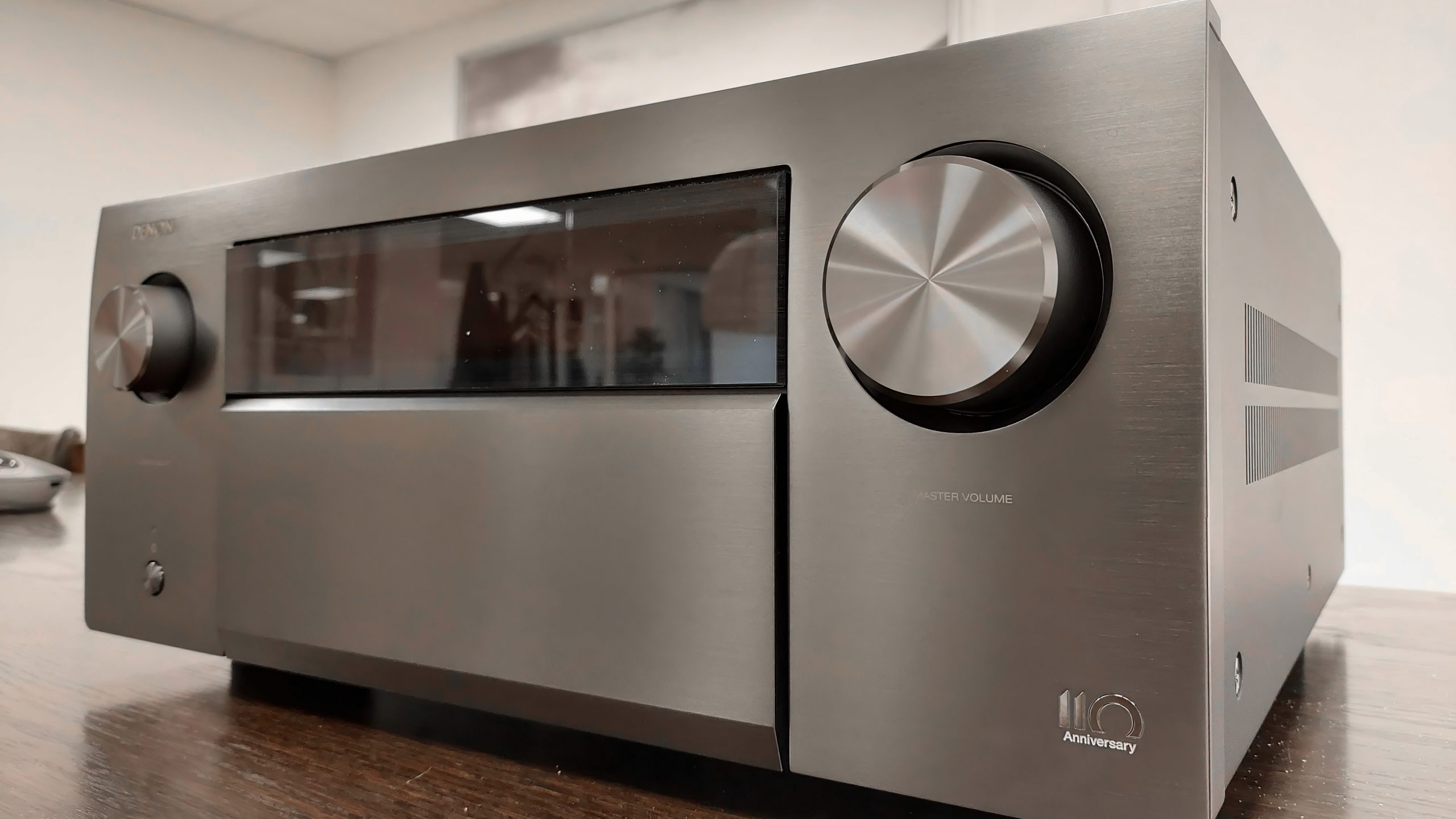
Finally storage capabillity
With the predecessor AVC-X8500H, I missed the ability to store various speaker calibrations in memories. For example, if I wanted to find out if the speaker configurations 7.1.6 or 9.1.4 worked best for me. With its predecessor, you had to do autocalibration again every time you moved the speakers. But Denon has listened to common sense, because now you can save two different layouts! This makes it much easier to switch between two different layouts. Or use the memories to, for example, switch between configuration with and without subwoofer. If you want a setup without a subwoofer for use late at night when you do not want to bother others trying to sleep. The possibilities are many.
The speaker system
Our fixed speaker setup in the test room is a Procella THX system in 7.1 configuration, with a pair of ceiling-mounted Martin Logan SLM for Atmos content. This is mostly what I listen to.
But still. Because the amplifier actually has 13 channels, I need more speakers to test most of its potential. But it presents a big challenge, namely that I do not have access to enough speakers of the same type.
In the alternative setup, I use the large (and expensive!) Dynaudio Confidence 60 as front speakers, which I together with Sonus faber Olympica III also use to assess the sound quality in stereo. Because the Dynaudios sound so brilliant in themselves, I set the Audyssey system to Bypass L / R, which means that the front speakers are left uncorrected, while all other speakers in the setup are adjusted to sound as similar as possible to these.
I learned from my little brother that 7.1.6 setup works better than 9.1.4, partly because Atmos does not support Front Wide.
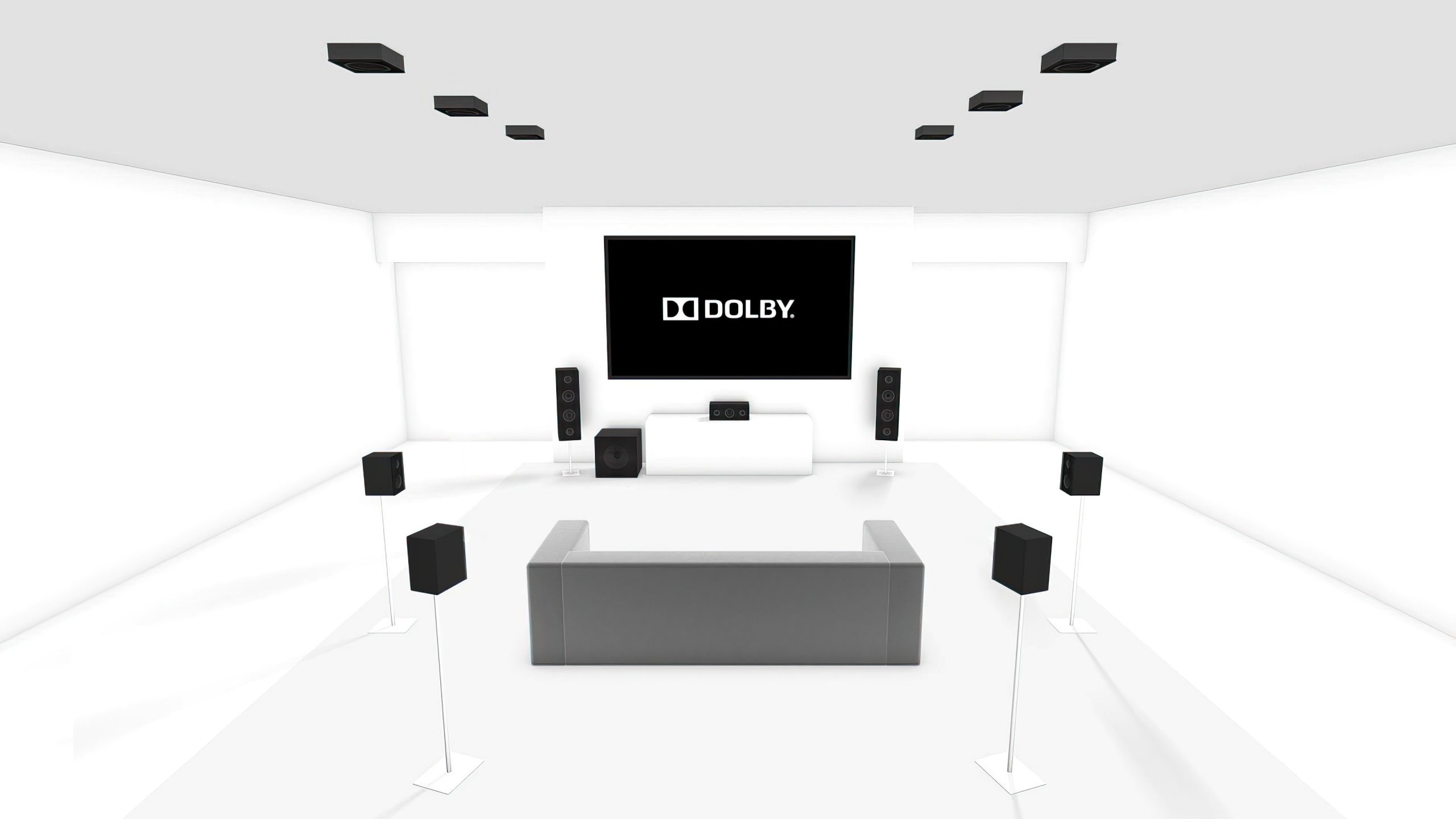
The layout is therefore as follows:
- Front: 2 x Dynaudio Confidence 60
- Center: Procella P6
- Surround: 2 x B&W AM-1
- Surround rear: 2 x JBL 4411
- Top front: 2 x Martin Logan SLM
- Top center: 2 x Procella P6
- Top back: 2 x Procella P6
- Subwoofer: Procella P15
Setup
Denon has a very simple step-by-step setup, which rents you by hand through speaker setup and source connection. The speaker calibration takes time, you should at least calibrate for six microphone positions in the room, preferably eight. Before you turn around, half an hour has passed. Then it is an advantage to go over manually and see that the crossover frequency, distance and sound level look correct. Our Procella speakers are almost always set to split at 40 or 60 Hz, but in reality they should be split at 80. This is what they are specified for, and as they can withstand the most beating. The subwoofer must also be checked, that it is at 80 Hz and not lower so that it becomes too inaudible, or higher so that it overlaps too much.
“Like the prison guard in The Shawshank Redemption, the Denon amp loosens everything that moves, and holds an iron grip on the speakers.”
Roll film!
Then the fun can finally begin. And what a fun it is! Ready Player One has an energetic and hefty soundtrack, and with Dolby Atmos, the sound is painted around and over the audience. With our fixed Procella setup (7.1.2), where the front row is behind our acoustically transparent screen (DreamScreen V6), there is full control over everything. As the prison guard in The Shawshank Redemption, the Denon amplifier loosens everything that moves, and holds an iron grip on the speakers.
The amplifier controls the speakers playfully easily, and serves the sound with sweeping great dynamics. The use of surround and elevation channels is very good, and you get a real feeling of being moved into the film. Which fits well, as the film is about playing computer games in a virtual reality.
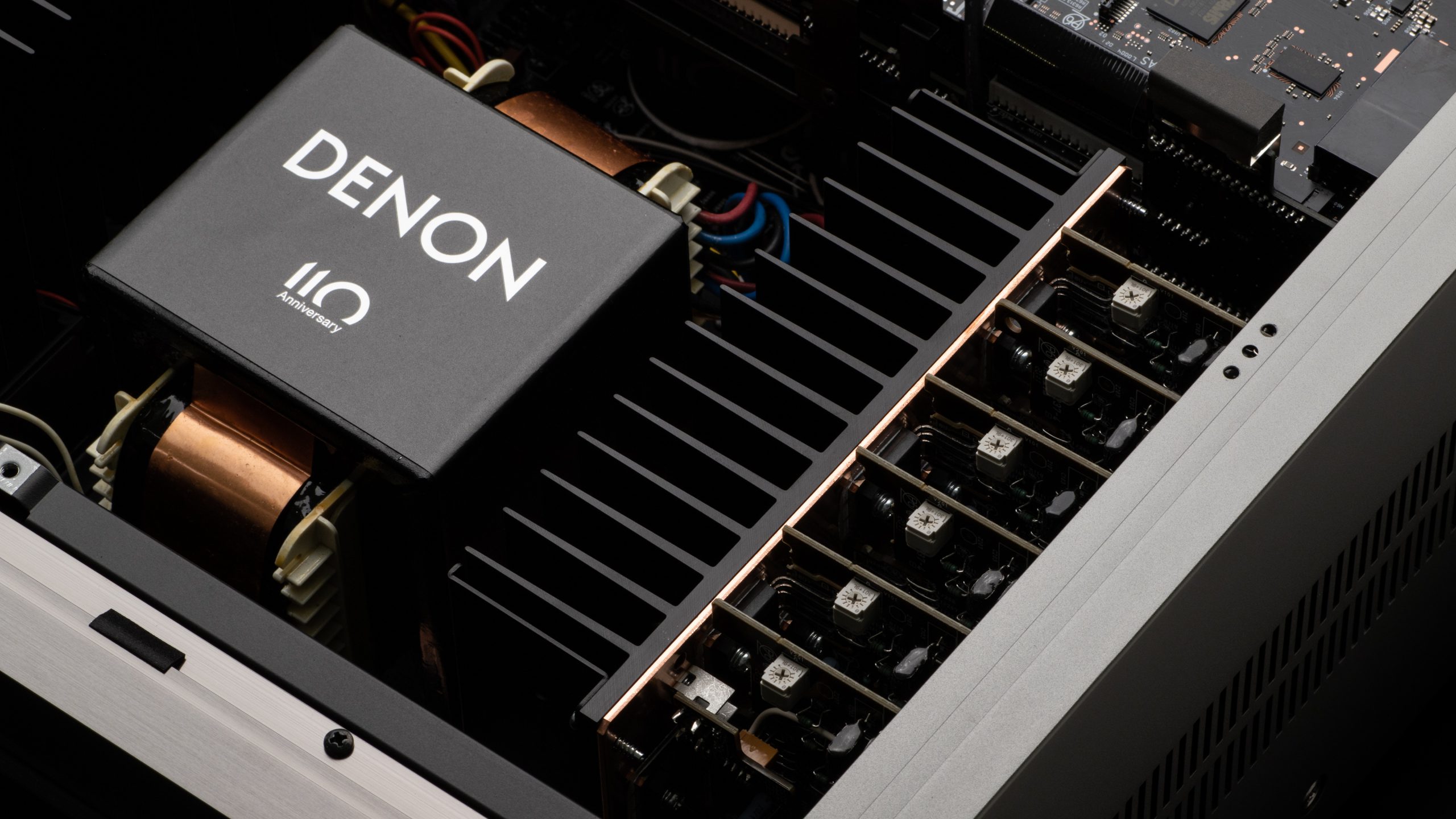
Audyssey sound mode
This speaker setup sounds best in Audyssey sound mode, where the correction system forces the speakers to follow their frequency curve. But do not use the Audyssey Flat, which sounds too slim and sharp at the top.
The dialogues sound open and colorless, with a control of the articulation as if you were thinking the Denon amplifier went to theater school! This diction is really few forunt, and the AVC-A110 does it without sounding stressed or assumed. Just natural. It sounds more fine-grained upwards in the harmonic range, than similar powerful amplifiers I have heard. Denon’s own AVC-X8500H included. It should then also only be missing, since the price has almost doubled. But it is not always a given that there is so much to be gained in a refined variant of the same construction. Here it is fortunately a good boost in sound quality, which was already sparklingly good.
Plenty of speakers
So what happens when the room fills up with 13 speakers? Well. Because we have more speakers, there will simply be more of all that cool stuff.
The sound from all the channels is woven together even more seamlessly, so that when a car flies through the air over our head, it sounds even more realistic. Although there are many speakers of different types here, the amplifier has evened out the differences, so that the speakers actually sound like a cohesive family.
The actual sound balance is somewhat different, because all the speakers are now adjusted in relation to the front speakers. Instead of the Audyssey having to choose the frequency curve. The result is a warmer sound, with more meat on the bone in the midrange range. There is more fullness in everything, in addition it shakes even more in the walls – and the trouser legs! Both because you have several speakers, and because the majestic front speakers go deeper into the bass register on their own.
The movie experience is simply even rawer now! As if you have walked from a good, enjoyable cinema hall, and taken the step into the rawest IMAX hall, where the sound effects fly through the air like projectiles. Here it’s just to bring out the popcorn, guys!
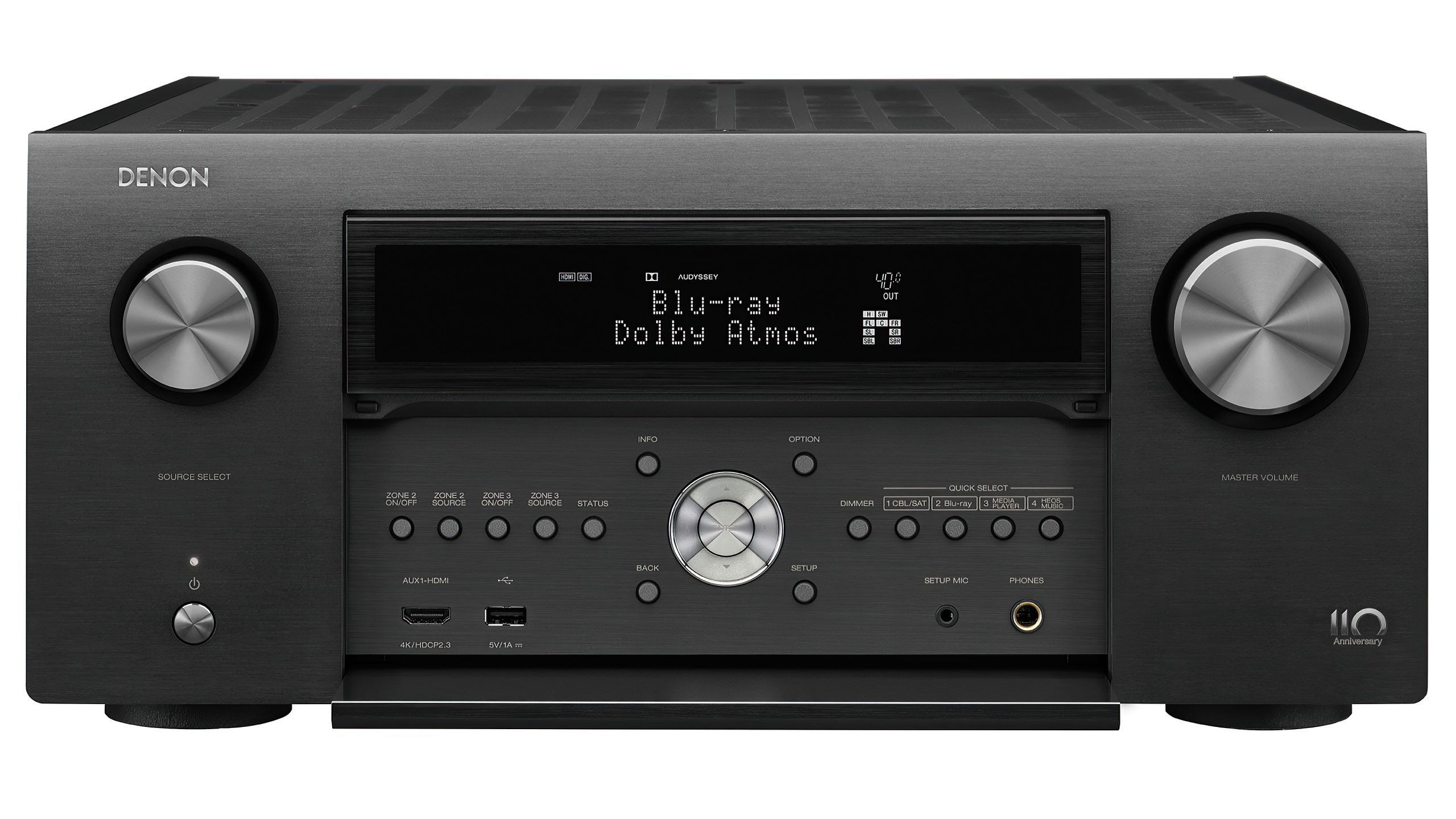
Music in all channels
Surround music is not only heard on big movies. There are also excellent music releases recorded with surround sound. The best examples of music that really do with the extra dimension of sound are the music company 2L.
Just take the release The Horn in Romanticism by Steinar Granmo Nilsen (historical horns) and Kristin Fossheim (hammer piano). The large room from the church they have recorded in is reflected by the sound system, and it is as if someone has knocked out our walls!
The horn has a great sound, while the whiff of the hammer piano is indisputable. This is a classic release that really deserves to be heard in full surround sound. And with the Denon AVC-A110, you get more sound layers and more air, so that the modernist pieces of music really creep under the skin.
Music in stereo
For music in stereo, many people will probably use the HEOS power system that is built into the amplifier. It is easy to use and supports many streaming services. But you do not get high-resolution MQA sound from Tidal here, only standard quality – but in lossless sound format. However, there is no doubt about the sound quality here. The fine country ballad Same Devil by Brandy Clark with chorus by Brandi Carlile, sounds with beautiful sound in Clark’s voice, and the steel guitar sings out of the big Dynaudio speakers. These are difficult speakers, but I think the amplifier works fine. It keeps up quite well with the giant McIntosh MA7000, and although it has to give clearly lost to the Hegel H590 (100,000 kroner, what would you have thought, sort of), it has a warm and large sound that fits the high-end speakers well.
It’s an even better match with Sonus faber Olympica III. The focus in the midrange on the electronic joike song Máze by ISÁK is impeccable, and the voice of Ella Marie Hætta Isaksen stands out beautifully from the speakers. The yoik lacks words, it catches up with emotions. And there’s plenty of it here! At the same time, the drums pull physically, and the electric tones hang like airy floats in the room. This is some of the best I have heard of stereo sound from a surround amplifier.
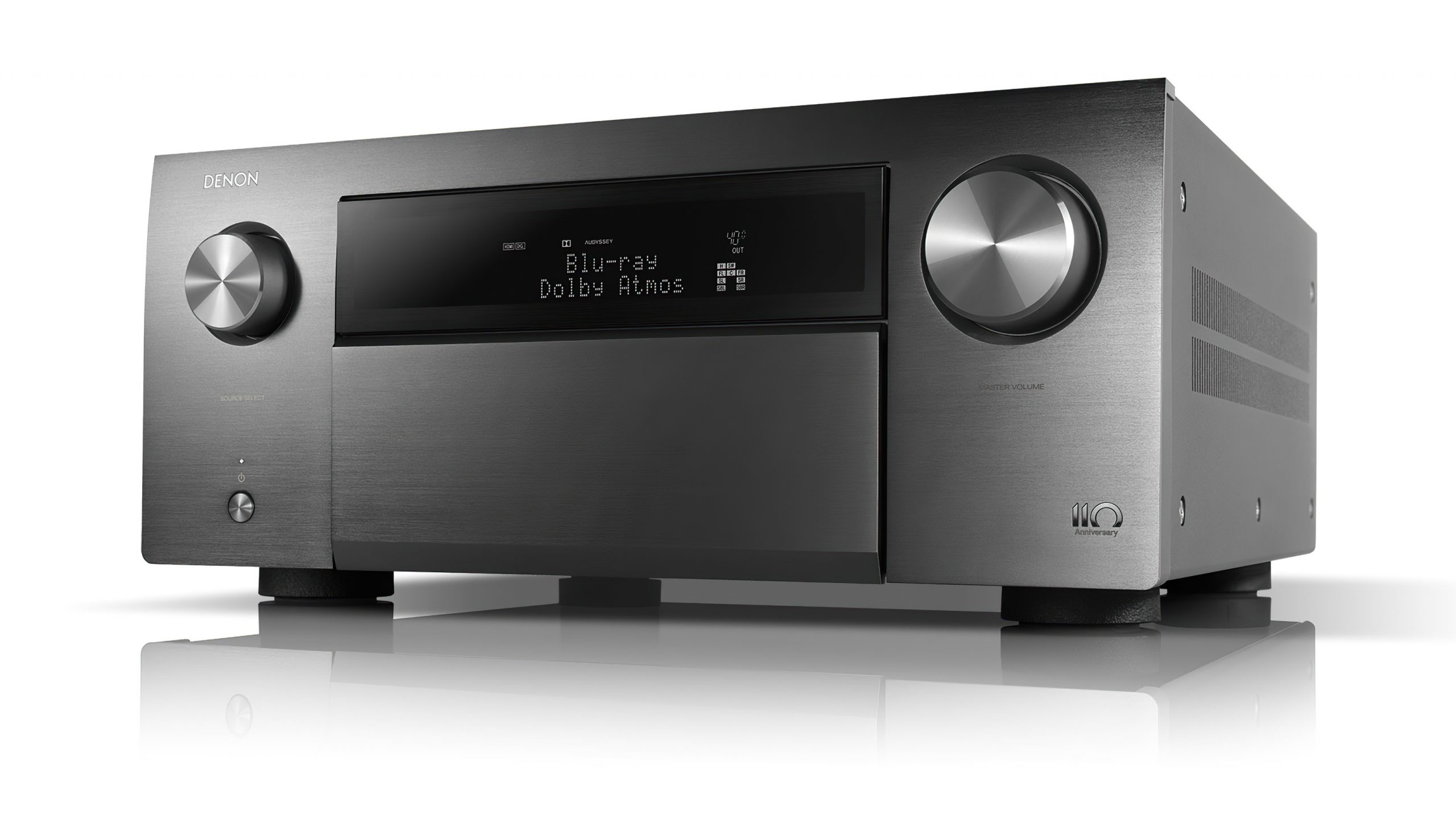
Conclusion
The Denon AVC-A110 is a stunningly unique surround sound amplifier. It takes the already raw AVC-X8500H and tightens up and refines the sound. Out comes tonal gold, which fills the room with timbre and emotion. There was plenty of power from before, here you just have to push on with decibels until you get sick. But now we have the latest layer of quality as well.
This sound quality becomes very expensive when you have so many channels and so much equipment under the hood. In this case, we look at 6000, and then you get a sound quality in stereo that challenges amplifiers like the Marantz Model 30 and which may also approach Denon’s own special amplifier PMA-A110 (3700). The AVC-A110 provides in a bag and sack for those who want to pay for it. You can call it expensive, but if you wait a year with the awnings you intended to install, then you will not notice it on the family budget anyway…
Tip: If you want a lot of this sound, but do not need as many channels and want to come down to a more sober price range, you can look in the direction of the Denon AVC-X6700H.

We think
Denon has surpassed himself. This is the best integrated home theater amplifier we have heard. At this price, it is allowed to expect some XLR connectors, especially on the subwoofer output. The speaker terminals are also in the same tight plastic as cheaper receivers.
5999 €
Specifications
- Power: 13 x 150 W (8 ohms, 2 channels)
- Number of processor channels: 13.2
- HDMI: 7 in (1 has HDMI 2.1), 3 out (eARC, 2 has HDMI 2.1)
- Audio formats: Dolby TrueHD, Dolby Atmos, DTS-HD MA, DTS: X Pro, IMAX Enhanced
- Room correction: Audyssey MultEQ XT32
- Services: Spotify Connect, Tidal, TuneIn Internet Radio
- Wireless: HEOS multiroom, AirPlay 2, DLNA, Bluetooth (2-way)
- Turntable input: Yes (MM)
- App control: Denon 2016 AVR Remote, HEOS
- IP control: Yes, supports voice control (Google Assistant, Siri, Alexa)
- Weight: 25.4 kg
- Color: Graphite gray metallic (Graphite Silver)
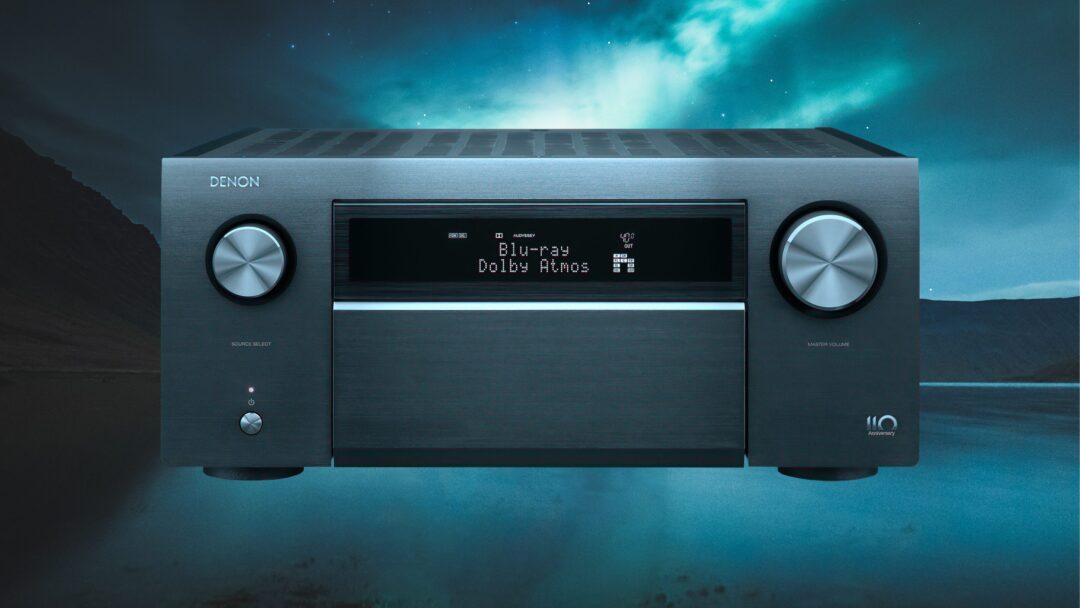

Pensez-vous que l’AVC-A110 après calibrage donne de meilleures performances que le PMA-A110 sur une écoute 2.0 ?
Do you think the AVC-A110 after calibration gives better performance than the PMA-A110 on a 2.0 listening?